Eiffel Tower
- Address: Champ de Mars, 5 Avenue Anatole France, 75007 Paris, Francia
- Tags:
 What to see Paris,
Paris,
France
What to see Paris,
Paris,
France
- Telephone: +33 892 70 12
- Website: www.tour-eiffel.fr
A winter's night at the Eiffel Tower

During the winter of 2014, my friend Yuliana and I, who was only in Europe for two weeks, started our journey across the European capitals. One of the places we wanted to visit most was Paris, and of course go to visit one of its most famous monuments, the Eiffel Tower.
We had spent months and years dreaming of the day we could finally visit it, and when we got to it we could hardly believe it was real life, it felt so surreal! The truth is that, we had an idea of what we expected the city to be like, and we were impressed by many of its great monuments, however, because imagination is often different to real life, it was less magical than we had expected.
It was our first night in Paris, we had just arrived from the airport and a after we had left our luggage at the hostel, we started to walk to the Eiffel Tower, of course! I had to see it at night, and at during the day, well every hour that we could!
We took the metro from the Gare du Nord station, it is worth mentioning that the subway system is very efficient and easy to take, I just recommend you to use a map. From the station, you have to walk a little, we couldn't see the tower through the buildings so we walked and walked in the direction of the map until finally it appeared. It was beautiful and illuminated, just in the distance through the alleys we saw it.

Seeing it in the distance, we felt as if our dreams had finally come true, which to me was the most exciting feeling in the world! In the end, we snapped back to reality and it was cold again.
When we arrived there, it wasn't surrounded by snow as we had seen so in the pictures, everything was dry and a little damp. But the great iron stands stand upwards so tall, and then it started its spectacular light show.

Suddenly, the whole tower began to twinkle, tiny little lights flashing on and off up and down the tower. It was quite quiet whilst we were there, so I guess it was a totally different way to see the Eiffel Tower, with no tourists, no flowers, no snow, but it was still beautiful and was still the famous tower.
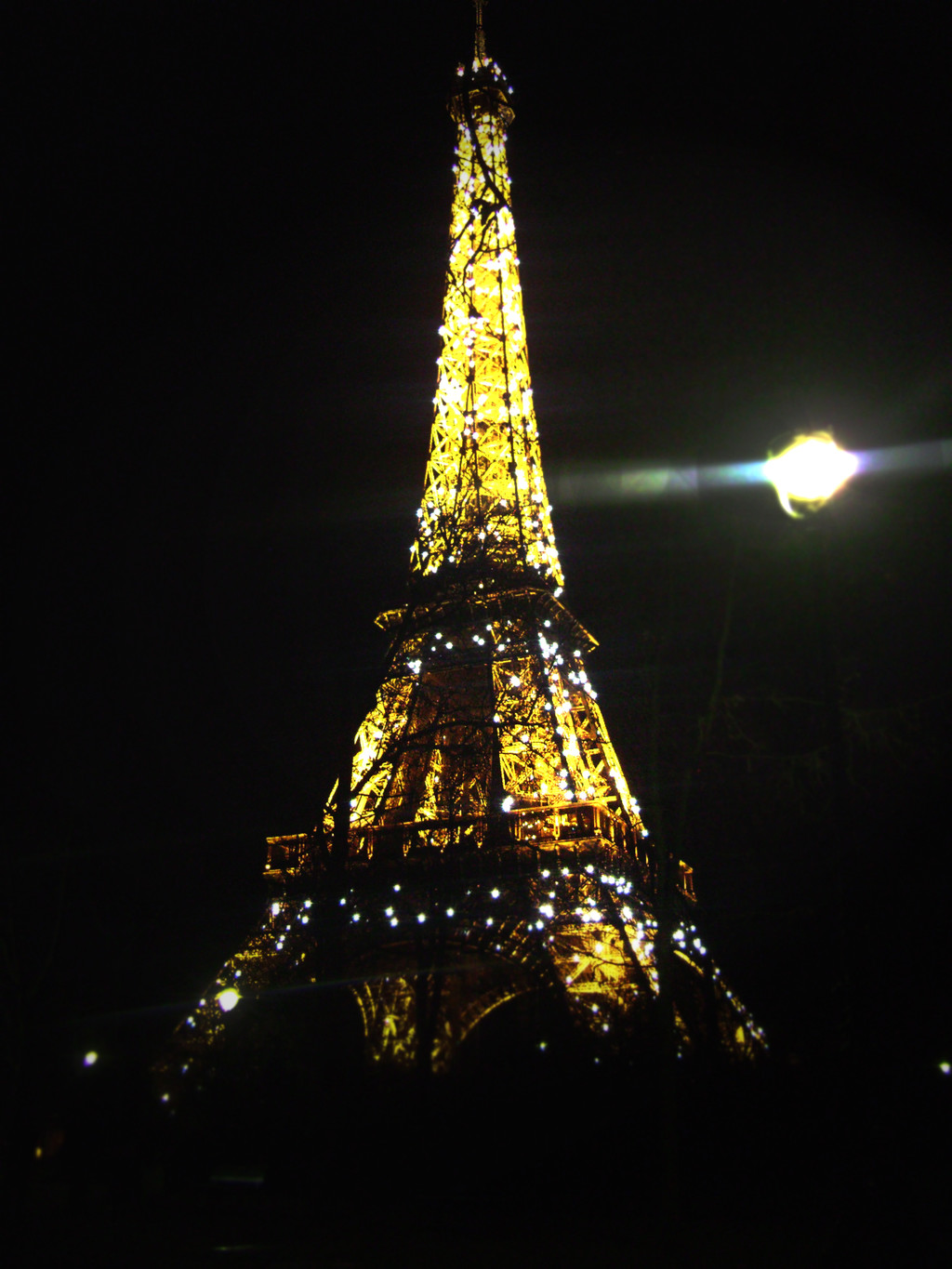
We walked all around it and looking from beneath it, it was even bigger than I imagined. The design was much more simple than what I had imagined, which was something I learnt during this trip... sometimes simplicity is the most effective. I also learnt that everything can be totally different from what first imagined, sometimes the most famous is not the most beautiful, but everyone has their own personal opinion.

In the city of romance, you must experience everything, and we accomplished our dreams visiting this masterpiece. I can't imagine visiting Paris and not visiting the Eiffel Tower. :)
Photo gallery
Content available in other languages
- Español: Una noche de invierno en la Torre Eiffel
- Polski: Jedna zimowa noc na Wieży Eiffel
- Italiano: Una notte d'inverno alla Torre Eiffel
Lights and the city
The grand tower from the 19th century continues to take pride in being the crown of Paris.
The Eiffel tower is the icon of Paris and also the top tourist destination of France. Even in the entire world, it is one of the top spots for tourism. Designed and built well over a hundred years ago, the tower deserves this stature. Its beauty gives tough competition to any masterpiece of modern infrastructure. The tower is made up of tonnes of iron which consumes tons of paint each time it is coated to stay young and beautiful. Each year, millions of visitors climb up the Eiffel tower and that makes it the most visited paid monument in the entire world! With all these facts and many more, Eiffel tower is synonymous with Paris' symbol.
Whether you see the Eiffel Tower from anywhere in Paris, or you look at the rest of Paris from the top of the Eiffel Tower, it is a unique experience. This article will take you to one of the millions of experiences of visiting the Eiffel Tower. Read on for additional information about location, price of the tickets and how to reach.
Story before visiting
I can not speak for everyone, but when I plan to visit a place with a story, I prefer to know the story behind it before experiencing it.
The Eiffel tower has many interesting stories, some ecstatic, some that ended on a sad note.
The following points made me understand the long history of the tower better before visiting it-
-
It was built for the world fair of the 19th century that was held in Paris. However, it was built in order to be taken down 20 years after the Exposition ended.
-
Gustave Eiffel, the engineer behind the making of the Tower, had an office on the top floor. So, we can see what the mastermind saw from the top of his masterpiece.
-
To prolonge its life, Gustave allowed scientific experiments from the tall tower. He succeeded as wireless transmission (including radio waves) proved quite helpful. Even today, the tower hosts dozens of antennas for l'Ile de France. There you go, not many people know but Eiffel Tower was the tallest structure in the world for a very long time. This is the reason why it has indeed contributed its bit to the scientific community.
- Franz Reichelt, a tailor who claimed to have made a suit that enabled humans to fly, jumped (fatally) while wearing his suit (and getting the video recorded) to prove his point.
These are some of the facts that make the Eiffel Tower more than just a beautiful tower. They make it clear that it is an architectural masterpiece that has had significance in history of France and in some ways in the world.
I have met some people who come to the city and visit a lot of places but not the "touristic places" which of course includes the Eiffel Tower. My advice to them would be to read about the Eiffel Tower and I am sure then they would realize that the tower is indeed much more than just a beautiful touristic spot.
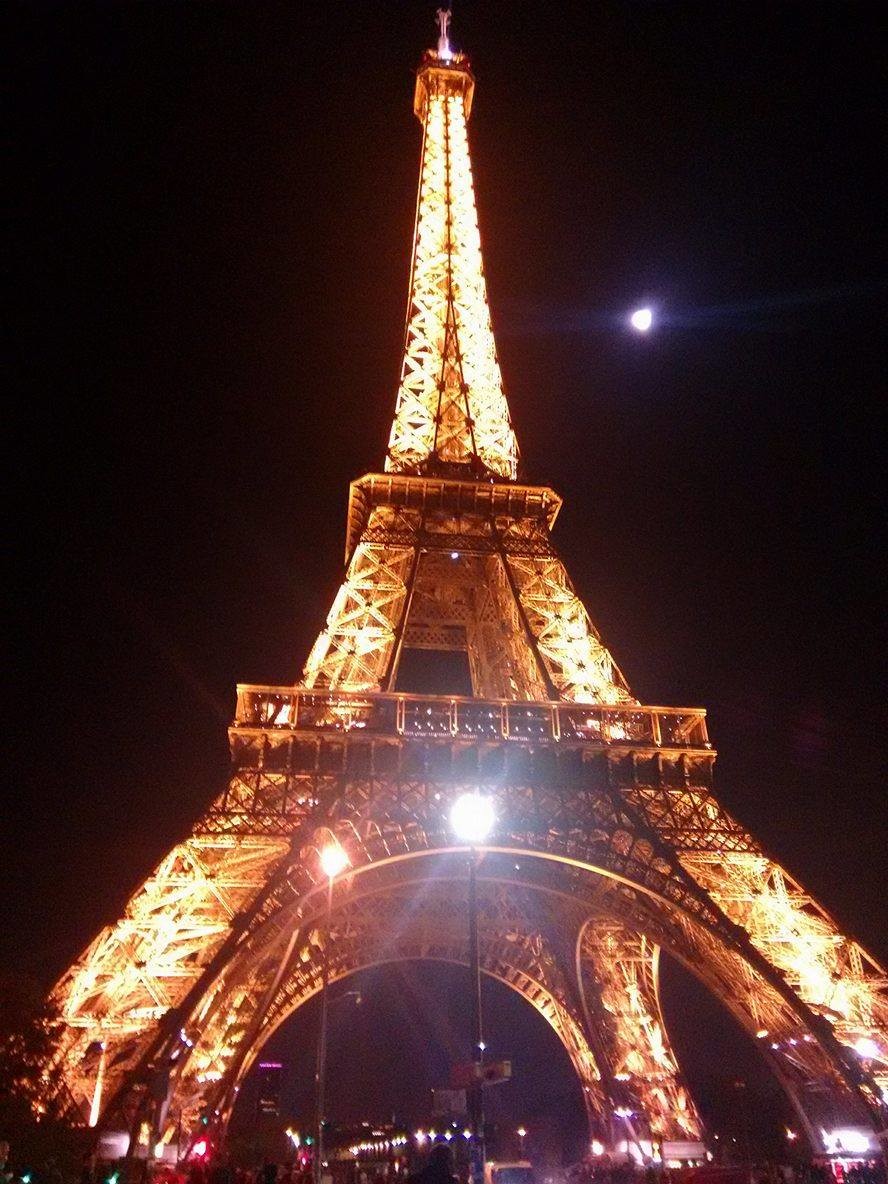
The Eiffel tower at night as seen from near the base.
To me, it's almost as if there are 2 Eiffel Towers (that's a bonus! ). One- in the afternoon and the other- at night. Both look different and make Paris look different. In the daylight, you can clearly see the bronze colour of the tower. At night, the tower lights up, generally in yellow, and glitters every hour in white sparkling lights. From the top of the tower, you can see the whole city of Paris lit up. The beauty of the entire city as seen twinkling in the dark is the biggest plus point of climbing at night. La Defense and Champs-Elysees also looks amazing at night. In addition to the lit up tower and the hourly twinkling, the bright beams of light from the top of the tower reach far into the city as they rotate around.
If you are lucky, you can get to see the Eiffel tower lit in lights of multiple colors or amidst fireworks. It is also recommended to be careful about your belongings in this top tourist destination of France.
The river Seine is an amazing combination with the tower. Cruises cruising along its flow, the area has a charm to it and hundreds of people enjoy at all points of time here.
Visiting the Eiffel Tower
The Eiffel Tower is known as "Tour Eiffel" in French. For a very long time, I used to believe that it stands for taking a tour of the Eiffel Tower. But no, as you probably guessed correctly, it makes more sense that the word "tower" translates to the word "tour" in French.
The Eiffel tower is near the river Seine, where cruises take tourists on a tour around the city. The tower is in the 7th arrondissement of Paris. There are a number of train stations at walking distance from the tower, notable, Champ de Mars-Tour Eiffel (RER C), Bir-Hakeim (M6). It can be also reached by a few buses.
As I walked towards the Eiffel tower, I felt it was not as close as it seemed at first, due to its grandeur. But nevertheless, it gave me sufficient time to appreciate it.
The waiting time on the long lines at the bottom of the 4 bases of the tower goes by easily - while looking up at it, taking the first pictures, looking at everything going on around and chatting. If you forgot to bring your selfie stick, don't worry. You will find those and much more available by sellers roaming near the base of the tower.
And then, there is the hourly twinkling and glittering of the tower that is simply mesmerising. Sometimes it goes on for 5 minutes, you get enough time to gaze and take it in, and also click amazing pictures. It is simply amazing and beautiful.

The view overhead while waiting in the queue
Originally, the four pillars of the tower did not, as can be assumed, have the lifts that they have now. Neither did the vertical lift between the second and the top floor exist. Either the staircases were used, or manual lifts (that extensively used pulleys) were used. Today, there are lifts (slant at the angle of the 4 pillars) that run between the ground and the second floor and then one vertical lift between the second and the top-most floor.
On the first floor of the tower, you will also find information about tall buildings around the world in different cities of different countries. The height of those buildings is also written in metres and you can compare them with each other and with the Eiffel Tower. Whether you decide to take the stair or the lift, it will be interesting. I preferred the stairs. Now that you have come so far, do not limit yourself to the first or the second floors. Go up to the top! There is the best view, (Gustave Eiffel's office view) and his office and life-like mannequin!

Gustave Eiffel's office.
The city looks beautiful, as expected, from the Eiffel Tower. Walking around, you can see everything you want to in Paris: the giant wheel at Champs-Elysees, the beautiful and shimmering La Defense, the river Seine, Les Invalides and so on.
Transportation
There are several options to reach the Eiffel Tower. It is possible to reach by buses but among the options in train, RER station Champ de Mars-Tour Eiffel is quite convenient.
I know a few people who have not been up on the Eiffel Tower even though they have lived here for years. I have strongly recommended them to break the trend. It may or may not live up to your expectations fully, but visiting the Eiffel Tower is totally worth trying, to say the least.
Read more about the Eiffel Tower if you would like to and enjoy not just the beauty of the tower and the city view, but also live the experience like it is meant to be lived !
Photo gallery
Content available in other languages
- Français: Les lumières et la ville
- Español: Luces y la ciudad
- Italiano: Le luci della città
Eiffel Tower

The Eiffel Tower continues to be the most impressive, spectacular, colossal and visited tourist attraction both in Paris and in Europe. More than 7 million people visit this iconic tower every year, according to the attraction's official website. Since its opening in 1889, 250 million people from all over the world have enjoyed all that the Eiffel Tower has to offer. Without a doubt, the best gift it gives us are the sensational and beautiful panoramic views of the city of Paris. Both during the day and at night, the City of Lights excites and leaves baffled all those who look at it from any of the Tower's three public levels. On one side, it sits on the Champs de Mars, where, during the Christmas period, a little Christmas market is set up, where you can enjoy amazing views of the sheer size of the monument. On the other side, it crosses the River Seine and is located in the Trocadero, both the Parisians' and the tourists' favourite area to enjoy a chilled day, sitting down on the grass to eat a crepe and admiring the unique beauty of 'the Iron Lady'.
Its three levels are the home of two restaurants, various buffets, a banqueting suite, a champagne bar and lots of gift shops.
The tower is open to the public 365 days a year, with opening hours varying according to the season. From June to September, the tower stays open until Midnight. The ticket prices vary, but visitors can arrive between 10am and 2pm and pay 50€ per person to access the tower's three public lifts and 704 steps. Tickets are available on the Eiffel Tower's website or at the ticket offices located at the attraction's base.

HISTORY OF THE EIFFEL TOWER
It was at the Exposition Universelle in 1889, a date that marked the 100th anniversary of the French Revolution, when a big contest was launched in the Official Journal of the European Union. The idea was "to study the possibility of erecting an iron tower on the Champs de Mars with a square base, 125 metres wide and 300 metres tall". Selected among 170 proposals, those whose had theirs accepted were: Gustave Eiffel, Maurice Koechlin and Emile Nouguier, both engineers, and Stephen Sauvestre, an architect.
The first excavation work began on 28 January 1887. On 31 March 1889, the tower had been finished in a record time: 2 years, 2 months and 5 days, and it was established as a true technical feat.
The project of constructing a 300 metre high tower was conceived as part of the preparations for the Exposition Universelle (a world's fair) in 1889.
Emile Nougier and Maurice Koechlin, the two chiefs of machinery in Eiffel's company, had the idea of building a very tall tower in June 1884. It was designed to be a large tower with four steel beam columns, separated at the base and then coming together at the top with more metal beams placed in-between them. The company, at this time, had completely dominated the beginning of the construction of bridge supports. The tower project was a daring extension of the latter, an extension taking them 300 metres above ground. On 18 September 1884, Eiffel registered a patent "for a new configuration that allows the construction of metal supports and towers capable of surpassing a height of 300 metres".
With the goal of the project being more widely accepted among public opinion, Nougier and Koechlin hired the architect Stephen Sauvestre to work on the project's appearance.

Sauvestre proposed pedestals to cover the legs, monumental arches for the columns and the first level, large rooms with glass walls on every level, a bulb-shaped design at the top and other ornamental elements to decorate the whole structure. In the end, the project was simplified, but certain elements - like the large arches at the base - were kept, which, in part, gave it its characteristic appearance.
All of the elements that were going to form the tower's structure were prepared in Eiffel's factory, situated in Levallois-Perret in the outskirts of Paris. Each of the 18, 000 parts used were designed and specifically calculated, drawn with an accuracy of one-tenth of a millimetre. A team of builders, that had worked on large metal viaduct projects, were responsible for 150 to 300 workers that formed part of the assembly team for this gigantic game of construction.
All of the metal parts of the tower were held together by rivets; a refined method of construction at the time of the tower being built.
Firstly, the parts are assembled in the factory with bolts, to later be replaced one-by-one with rivets. A team of four men was necessary for every rivet assembled: one to heat it, another to keep it in position, a third to shape its head, and a fourth to permanently place it.
On the Seine side of the tower, the builders used metal crates and injected compressed air into them, so that they were able to work below the water level.
The tower was assembled using wooden scaffolds and small steam cranes mounted onto the tower itself.

The assembly of the first level was achieved with the use of twelve temporary wooden scaffolds each 30 metres high, and four more scaffolds each over 40 metres high.
On 7 December 1887, the joining of the large beams up to the first level was completed. The parts were transported by steam cranes.
It took five months to build the foundations and 21 months to finish the assembly of the metal parts of the tower.
Taking into account the rudimentary means available in this period, this could be considered as a record speed. The assembly of the tower was a marvel of precision; all of the reporters at the time were in agreement in highlighting it this way in the press. The construction works began in January 1887 and ended on 31 March 1889. On the narrow platform at the top of the tower, Eiffel received his award from the Legion of Honour.
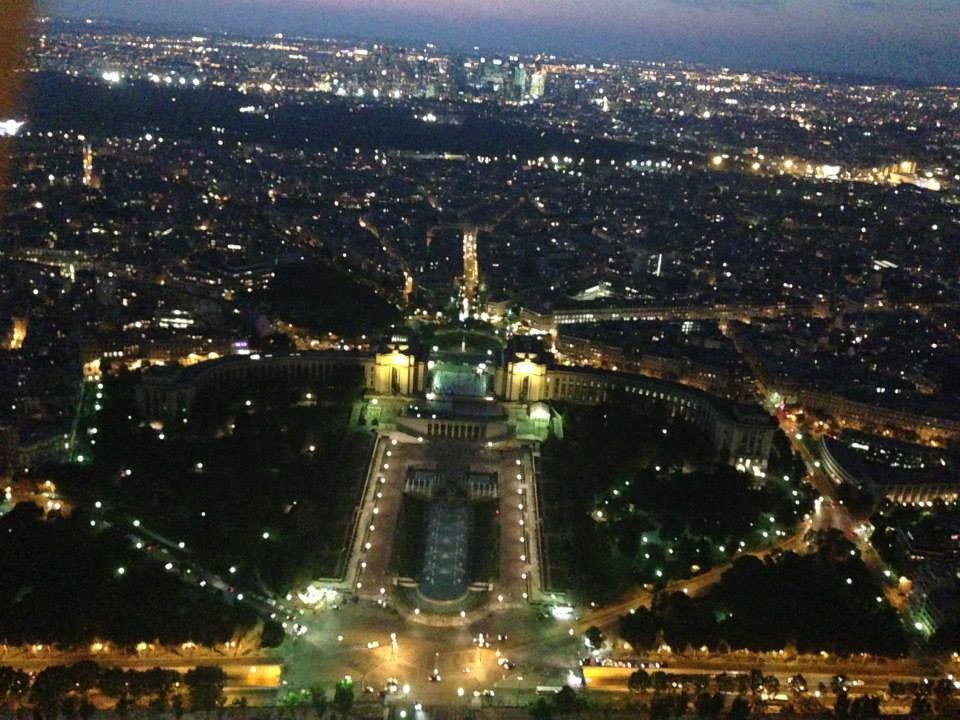
SOME INTERESTING FACTS
- Gustave Eiffel used wrought iron in the construction of the tower to demonstrate that the metal could be as strong as stone, and, at the same time, more lightweight.
- The construction of the Eiffel Tower cost 7, 799, 401. 31 FF (French Francs), which was the French currency at the time.
- The Eiffel Tower is 324 metres high, which includes the tip on the main architectural frame. Without the tip, it would be 300 metres high.
- It was the highest man-made structure until the construction of the Chrysler Building in New York City in 1930.
- The Eiffel Tower weighs 10, 000 tonnes.
- There are five million lights on the Eiffel Tower.
- The French gave it the nickname, 'La Dame de Fer', or 'The Iron Lady'.
- The first level is 190 metres above ground; the second level is 376 feet above ground; and the third level, almost 900 feet.
- The Eiffel Tower has 108 floors. However, visitors can only climb the stairs up to the first level. There are two lifts.
- One lift at the Eiffel Tower covers a total distance of 103, 000 kilometres a year.
- A few days after opening, Gustave Eiffel set up a meteorology lab on the third level, inviting scientists to use the laboratory for their investigations.
- The French Army used the tower to communicate wirelessly with the ships in the Atlantic Ocean during the First World War.
- The tower has more than 120 antennas, transmitting radio and television signals throughout the capital and even in the suburbs.

WHO WAS GUSTAVE EIFFEL?
Gustave Eiffel, after the global success of his creation, commented: "I should be jealous of the tower because it is more famous than I am. " An amusing observation, but, in reality, it was a very true one. Despite a long and illustrious career, Eiffel was almost unknown outside the engineering circuit throughout his life.
Born on 15 December 1832 in Dijon, France, Alexandre Gustave Eiffel grew up to be an engineer at a time where those in this profession were widely considered to be ignorant and uneducated. Eiffel, however, did not fit this affirmation. He was a great admirer of classic literature, with an extensive library of books bound in leather; amongst those, works of Voltaire, Zola, Victor Hugo and others. He published 31 books, documenting his numerous projects and experiments that he carried out during his lifetime. It was well into the 1880s that he received honours and awards from governments all over the world.
Eiffel's sophistication and elegance was not surprising when taking into account his ancestry. Eiffel's family on his father's side had built a very prosperous tapestry business in France, that had provided many generations with a very comfortable life. In the 18th century, the merchant weavers were considered to be members of the commercial elite, therefore, Eiffel's origins were an interesting combination of the bourgeoisie and craftsmen. It was Eiffel's father who, however, put an end to the family's dynasty, when he rejected carrying on the family business, and escaped at 16 years old to join the army. Although he was a respected soldier who served under the leadership of Napoleón Bonaparte, Eiffel's father would not have earned such a respected status if he hadn't have married the daughter of a rich wood merchant in Dijon.
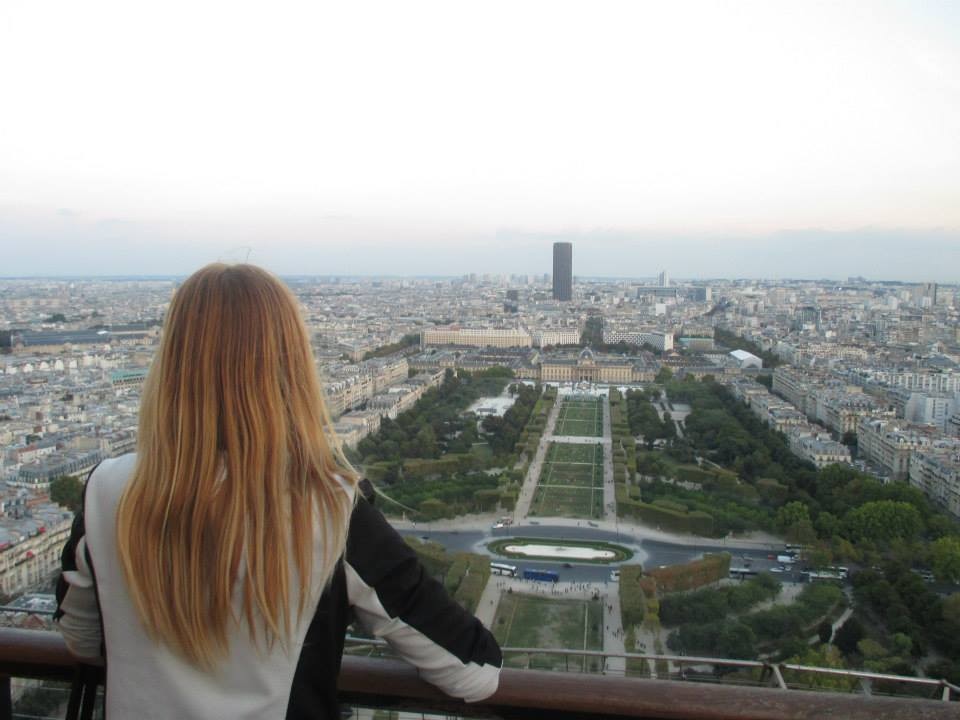
In turn, Eiffel's mother, was an intelligent woman, with an exceptional and brilliant business mind. She wasn't just responsible for Eiffel's early education, but she also managed a very successful carbon industry, as well as a shipping and delivery business. Later, Eiffel's mother also would help him to start his own business - he was always very attached to his mother.
Despite the success of their businesses, Eiffel's parents were considered 'new rich' ('nouveau riche') in France during the 19th century, a fact that later hindered Eiffel's attempts to marry in Bordeaux. When Mrs Grangent denied him her daughter's hand in marriage due to the families' differing social positions, Eiffel was left traumatised.
Eiffel ended up marrying Marie Guadelet, the granddaughter of waiter Edouard Régneau, in 1862. The couple had five children together and were married for fifteen years, until Marie contracted pnuemonia and died in 1887. Devastated, Eiffel spent 36 years as a widower without every remarrying.
During his youth, the two strongest influences in Eiffel's life were his uncle, Jean-Baptiste Mollerat, a successful chemist who had invented the process of wood vinegar distillation, and another local pharmacist, Michel Perret. The two men spent a lot of time with Eiffel and shared their knowledge about all manner of topics with him, like mining, chemistry, religion and philosophy.
However, the political beliefs of his uncle, Mollerat, caused a rift within the family which changed the course of Eiffel's life. At school, Eiffel was an extremely curious child, but wasn't the most studious. Whilst attending the Liceo Real, the boy became bored and felt that classes were a waste of time. His grades improved significantly thanks to finding a stimulus in history and literature classes - graduating in both Humanities and the Sciences.
Later, Eiffel attended the Sainte Barbé College in Paris, with the goal of preparing for the entrance exams to the prestigious École Polytechnique. Eiffel loved Paris and spent all his free time walking along the Seine, attending theatre performances and visiting the Louvre. When he wasn't accepted into the Polytechnique, Eiffel enrolled at the École Centrale et des Arts Manufactures, a private arts school that eventually came to be known as one of the best engineering schools in Europe.
Eiffel had plans to work with his uncle as a chemist in the vinegar process in Dijon, however, after some misunderstandings and fights between his parents and uncle, the boy could no longer accept this job, so he followed a new path.
With no job prospects in sight, Eiffel finally was contracted to work for an engineering business directed by Charles Nepveu, an official of the French Society of Civil Engineering. Although the company declared itself bankrupt not long after, Eiffel was hired as the Head of Research of the Belgian business that subsequently bought the company.
In 1858, at the age of 25, Eiffel achieved his first big breakthrough. He was given the responsability of supervising the construction of a 1, 600 foot cast iron bridge, that would cross the River Garona, close to the city of Bordeaux, which was to be completed in just ten years. With such little time to complete the project, Eiffel was inspired by a system of hydraulic presses. Not only did he finish the project, but thanks to his efficiency, he earned the reputation of an innovative and efficient engineer.
In 1864, married, he moved to Paris for the second time and decided to start up his own business. He dedicated 20 years to develop innovative methods that would allow him to construct a colossal and innovative piece of his own.

One of his first large projects that his own company carried out was the construction of the Sioule Bridge, which is situated 262 metres above the River Sioule, therefore meaning it was one of the highest bridges in the world at that time. The project made use of three important innovations: wrought iron was used, instead of heavy and brittle iron normally used for bridges, because it was more resilient and more flexible; the edges of the springs were curved, which were usually square or rectangular, to create a more durable and stable base; and, a system known as "release" was developed, to move the individual parts of the bridge more easily, as if it was a giant rocker.
Eiffel's reputation continued to grow with his list of projects, which included: prefabricated bridges for the military; the famous Bon Marché de París department stores; the iron framing for the Cathedral of Notre Dame; and his most notable work before that of the Eiffel Tower, the Statue of Liberty.
Created by the sculptor Frédéric Auguste Bartholdi, the Statue of Liberty was presented by the French as a display of goodwill and friendship to the United States in honour of its Centennial Exposition in 1876. Bartholdi had designed the figure of the statue at 151 metres high, but he didn't know how to build it in order to allow for its shipping to New York. Besides, he also didn't know which materials to use so that it could withstand the strong winds from the Atlantic Ocean. In the most doubtful moment, they introduced Gustave Eiffel to him, from whom he asked for help with the construction of the statue. Eiffel built a skeletal frame with iron so that the metal sheets could then be inserted, and fixed vertical steel beams at the granite base of the statue. The result was a more lightweight, but stronger statue that was capable of bearing great weight and the inclemencies of the weather. Once more, Eiffel had demonstrated his ability to resolve more complicated technical problems whilst using innovative techniques that no-one had dared to try using before.
In 1889, Eiffel's comprehensive experience and his innovative methods culminated in the construction of one of the most famous monuments in the world: the Eiffel Tower, located on the Champs de Mars. However, despite the thorough planning of three ambitious projects after the tower (the central metro line in Paris, a tunnel below the English Channel, and an observatory in Mont Blanc), the greatest success of the esteemed engineer also would be the final important structure that he built.
In 1887, Eiffel's company had begun to design and construct the patented locks that were going to be used in the Panama Canal project. However, less than one year later, the business that hired them declared themselves bankrupt, and project was stopped. For the next five years, an investigation about the bankruptcy was carried out, which lost the savings of hundreds of thousands French investors. Eiffel was accused of embezzlement of funds, and, for several years, invested a large part of his own money and energy into the fight against the charges. Eiffel was ultimately acquitted of all the accusations, but in 1893, Eiffel resigned as President of the Board of his company. Therefore, he could not carry out his three ambitious projects that he had in mind after the tower.
Over the following 30 years, Eiffel lived and worked in the tower that shared his name, which were, without a doubt, the most creative and satisfying of his life. He dedicated himself to other hobbies that had been left abandoned for a long time: meteorology, aerodynamics and telecommunications.
On 27 December 1923, Gustave Eiffel died at his home aged 91. Although Eiffel had been proud of his tower, he often felt that the extreme reputation that his colossal monument had earned silenced the rest of his achievements as an engineer and a researcher.
When Eiffel gave his family's name to his tower, he attributed it as an act of pride. But, with time, the name and the monument became one and the same, and people began to forget the man behind this masterpiece, remaining as a shadow of his impressive creation.
Therefore, the Eiffel Tower, despite being the biggest achievement of his life, has always felt like a bit of a contradiction. Nowadays, the disciples, followers and admirers of this renowned architect's works fight for the memory of Eiffel, the innovative man who gifted humanity much of the infrastructure that both millions of French citizens and foreigners alike enjoy today.
THE LEGEND OF THE EIFFEL TOWER
Among the many legends that surround the famous monument, there is one that especially interests me and is worthy of mentioning in this post: the legend comes from a report carried out in 1965 titled "The Eiffel Tower's Suicides", which relates the worrying fact of how people use the tower to commit suicide, jumping into the void from the top of the tower. Within this growing and sinister practice, we find ourselves among the stories of people who miraculously survived.
The most spectacular case was that of a broken-hearted 17 year old girl, identified only as Christiane, who made the jump from the tower in November 1964. The girl had arrived in Paris several months earlier from Normandy, with the dream of selling perfumes, however, far from reaching her dream, she found a job as a domestic servant. During this time, she met a young boy with whom she fell in love and became engaged to, but, just before the wedding, the boy broke off the engagement.
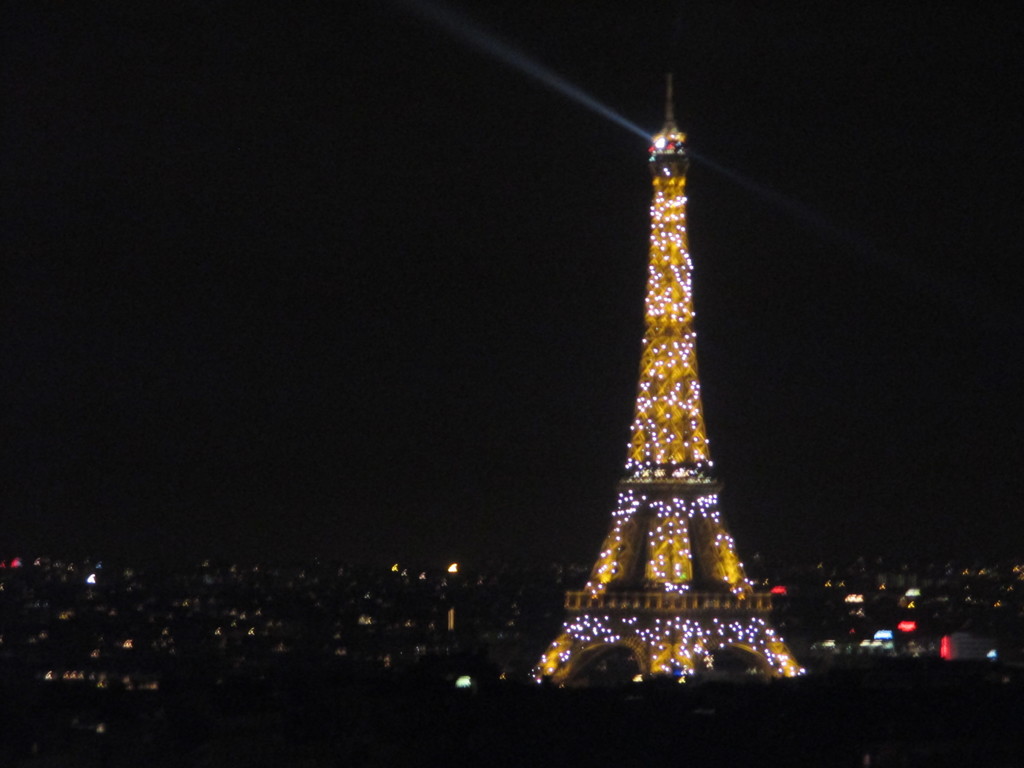
According to the legend, this very same day, Christiane went to the Eiffel Tower, took the lift up to the second level, but found that the railing was too high to cross it, so she went back down to the first level. After walking around in circles for an hour and a half, suddenly and in front of many astonished onlookers, she crossed the railing and jumped into the void, landing 182 metres below on the bonnet of a Renault Dauphine. She only broke a leg, with the car acting as a parachute, saving her life thanks to the impact onto the roof. However, the legend never mentions anything about the vehicle's owner.
"I didn't feel anything after I jumped", the suicidal girl said.
The news, which is a real story, became a legend the moment that an unexpected twist was added to the story, which tells that the survivor ended up marrying the vehicle's owner, but no news about it was ever reported. Maybe it's true, or perhaps it is a disguise to the true story that brings this halo of mystery, which will always remain hidden behind the iron frame that holds up the titanic monument.
If you are interested in learning some other cool things about Paris, or if you happen to be looking to spend New Year's Eve there, check out this post.
Photo gallery
Content available in other languages
- Español: Torre Eiffel
- Italiano: Torre Eiffel
- Français: Tour Eiffel
- Polski: Wieża Eiffla
Symbol of Paris and France
During a trip to Paris, you cannot miss off a visit to the Eiffel Tower ["Tour Eiffel", in French] from your itinerary.
This tower is known by anyone and everyone; I think that there are very few people in the world who don't know what it is. In fact, the tower is one of the most visited paid attractions in the world. For some people, it is the symbol of Paris, for others, of France as a whole. Inevitably, if someone said "Paris" to you, you would immediately think of the Eiffel Tower. Although, according to what some Parisians have told me, for them it is not something special, and there are some citizens who have never even visited it (this is somewhat normal, though, as you wouldn't usually go around like a tourist in your own city).
Gustave Eiffel was the individual who built the tower as the entrance for the World's Fair in 1889. Although it was only intended to stand for a couple of years, it is still with us today; in fact, I couldn't begin to imagine the city with the Eiffel Tower. From the project start to completion, construction works took a little over two years, with the tower being made of wrought iron and weighing 7. 3 tonnes.
It measures (right up to the tip) 324 metres tall and is made up of three floors: the first floor is 57 metres tall; the second, 115 metres; the third, 276 metres; and, a large antenna at the very top of the tower, which makes it even taller.
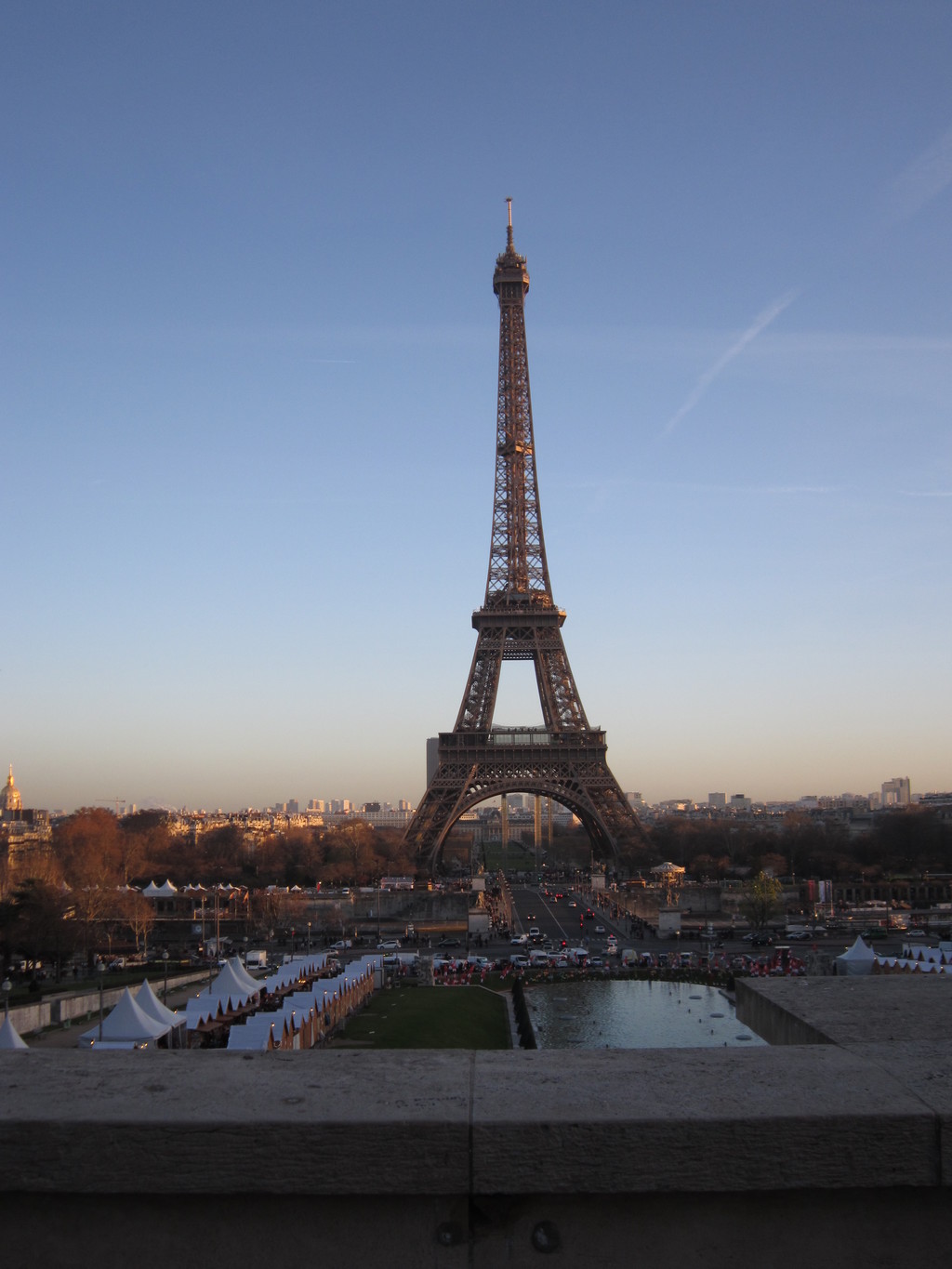
On the first floor, there is: a restaurant, a gift shop, the Gustave Eiffel function room used for events, a panoramic terrace, and a buffet. I understand that people are afraid of heights, but I think that, now that they have climbed up this far, they have to at least carry on up to the next floor...
On the second floor, there are more gift shops, another buffet, display cabinets, and a viewing panel that allows you to see down to street level.
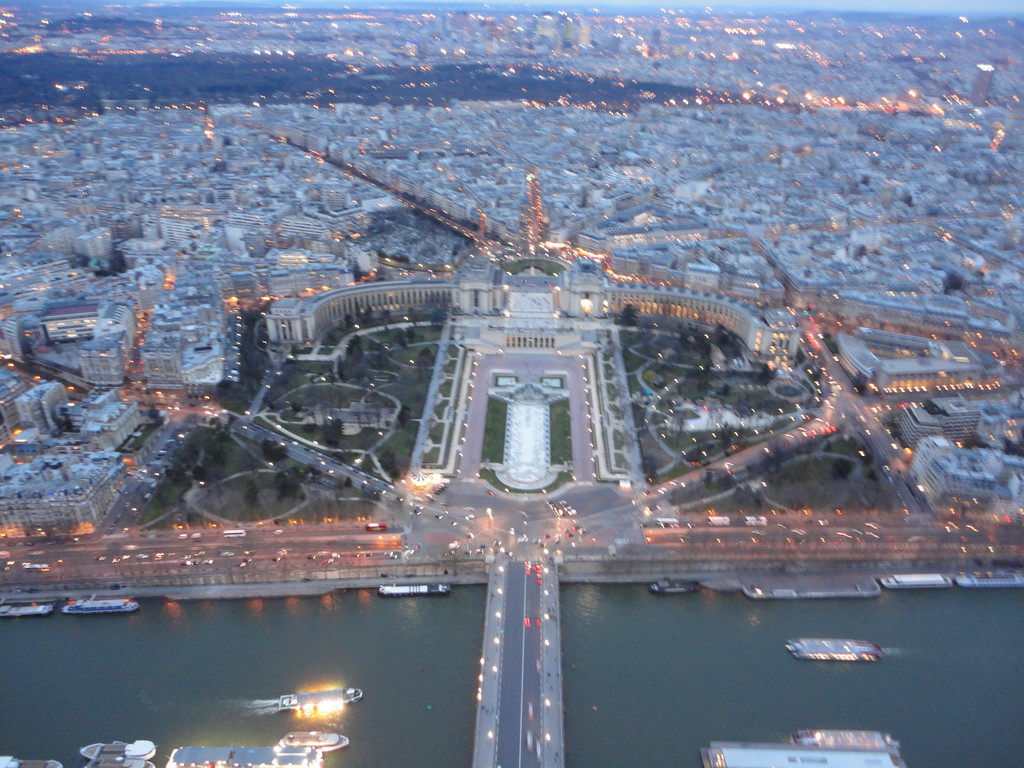
You can travel up to the third floor of the tower in a specially-designed passenger lift. When I did it, there was a bar where you could buy champagne upon exiting the lift. I personally didn't buy a flute because it was expensive, but it is common to celebrate your visit there in this way.
To travel up to the different floors of the tower, you have the option of stairs and passenger lifts. Admission fees vary in price depending on the floor that you want to travel up to, and whether you would prefer to take the stairs or the lift.
The tower's lighting is also very impressive. They change it for certain events or important dates in the national and international calendar. For example, on the day that I visited, the lights were paying tribute to Nelson Mandela with his name, date of birth, and date of death. Sometimes they use brightly coloured lights, depending on the occasion. I wouldn't know what to say I like the most... I think it is when the lights are twinkling, but sometimes, depending on the colours, they are a little bit ugly, if I'm honest.

I was left speechless when I stood just underneath the base of the tower and looked upwards; you get an incredible perspective of the monument in this way, which you could also have whilst lying down one of the benches close by, as it almost seems like the tower is going to fall on top of you. Aside from the view of the Eiffel Tower from below, I think the best view that you can get of it is from another monument or room that is relatively high up and allows you to see it in the middle of Paris. Personally, I have always like the photos of somebody eating breakfast in a hotel room with the Eiffel Tower sitting in the background (I will do this one day). I have seen the tower from the Arch de Triomphe and the Trocadéro.

It's a place that's typically frequented for both national and international events. At Christmas, an ice-skating rink is placed down close by, so the visual image that it creates with the tower in the background is just magical.
Of course, watch out for pickpockets that operate in and around the area, as there are obviously lots of tourists. There are also lots of black market vendors that sell souvenirs, and when the police come to patrol the area, they flee and run away whilst all of the miniature Eiffel Towers bang together and make lots of noise. Sometimes, these vendors can be a bit pressuring, but the best thing to do would be to keep your wits about you at all times.
When I went the first time, the lift up to the top floor cost around 11€, although I think that there are discounts available for both students and groups. The price will again vary depending on whether you are an adult, a young person (from 12 to 24 years old), a child, or you have disabilities. It will again vary based on whether you choose to take the stairs or the lift, and to which floor you would like to go up to. Standard adult admission, if you take the stairs to the second floor, for example, costs 5€, whereas it would cost you 15. 50€ to take the lift to the top floor (it is a big difference).
The tower's opening hours are as follows: 9am to 12am (midnight) from mid June to September (with it being summer, it has to be one of the best times to enjoy the views from the tower with a cloudless sky); and, during the rest of the year, 9:30am to 11pm. Although, I would say that it's best to check the opening hours on the website before going, as, on certain dates or occasions, they extend or shorten their hours of operation.
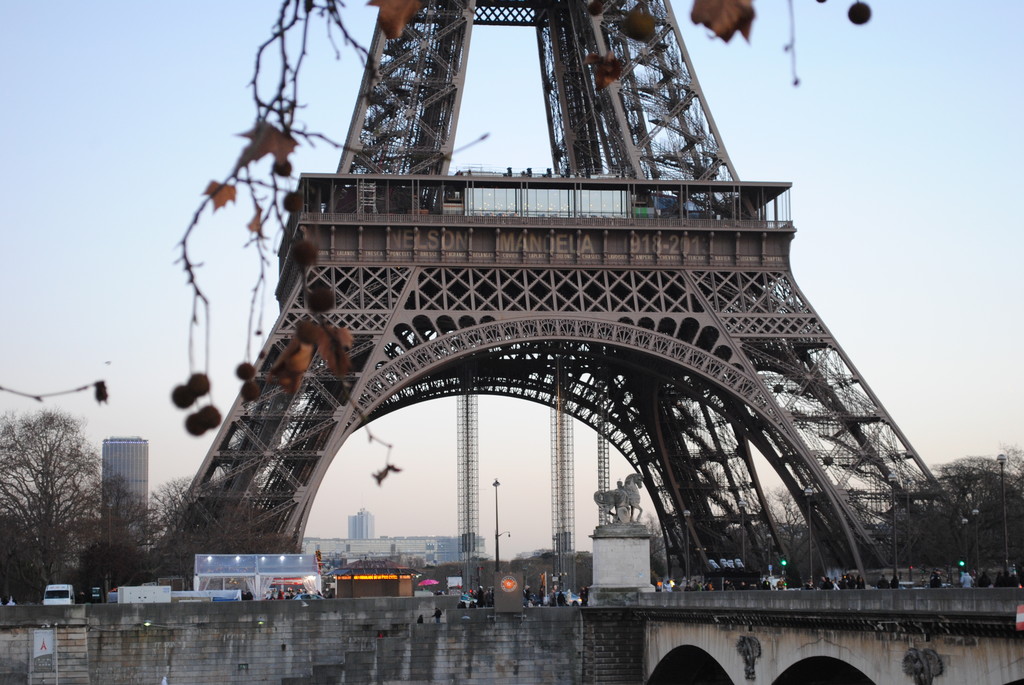
Another thing - bear in mind the distances you will have to travel to get to and from the tower. The first time I was in Paris, I went directly to see the Eiffel Tower as soon as I arrived, and, as it seemed to be quite close, I walked there. However, it seems like the more that you walk, the further away it seems to get... in the end, it took me an hour to get there in freezing cold weather, but it was worth it. I would also advise you to take care with the metro stop, as both suburban trains and metro services stop in many of Paris' stations, and the stop for the Eiffel Tower is, in fact, on an RER suburban train line.
Photo gallery
Content available in other languages
- Español: Símbolo de París y de Francia
Rate and comment about this place!
Do you know Eiffel Tower? Share your opinion about this place.







































